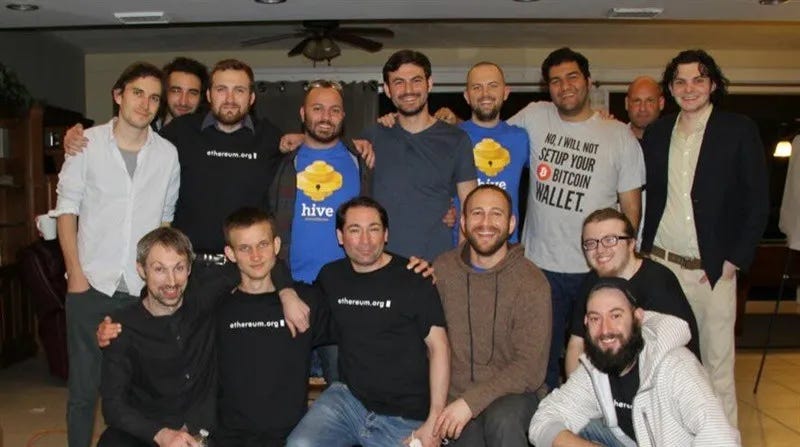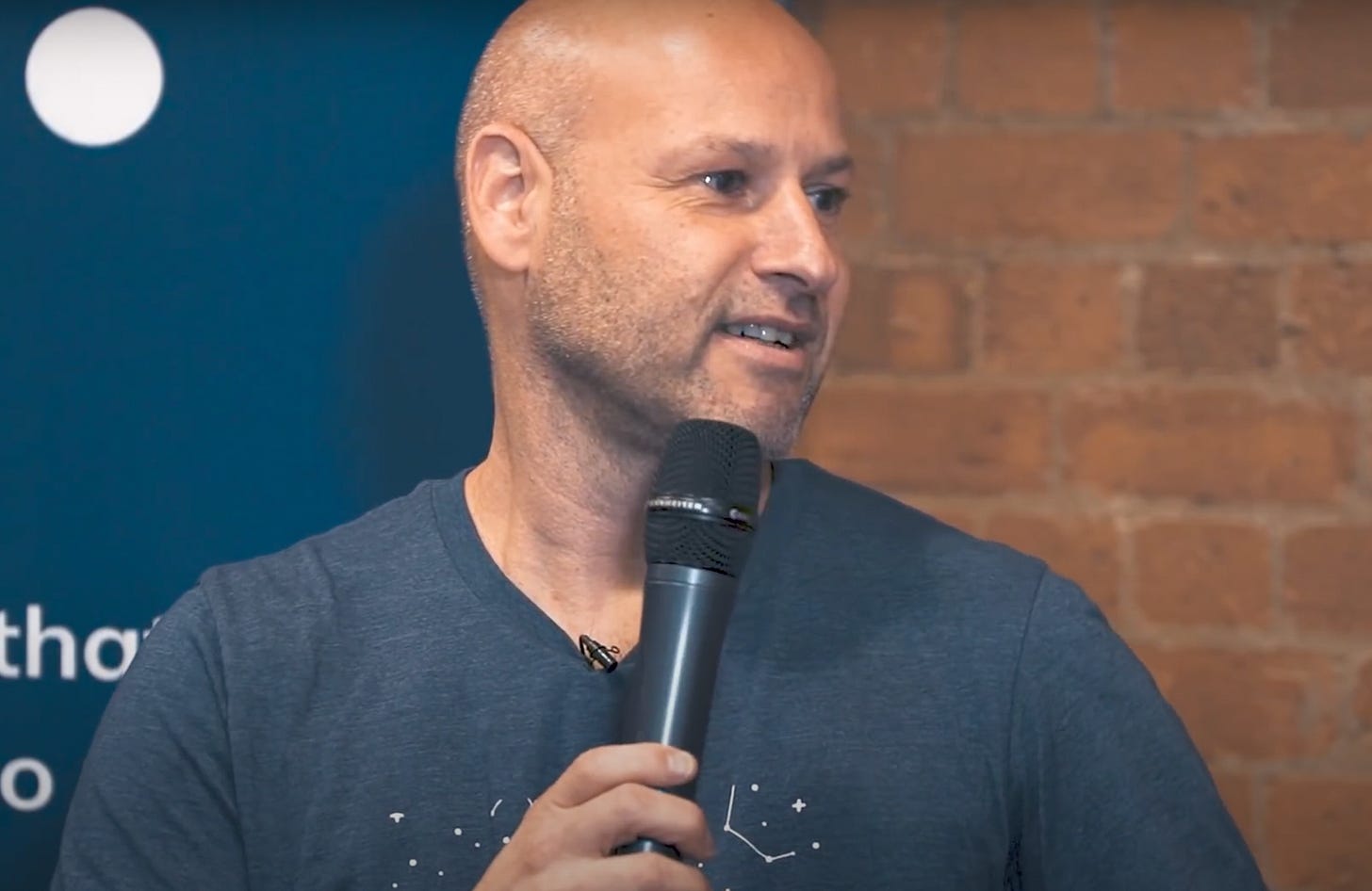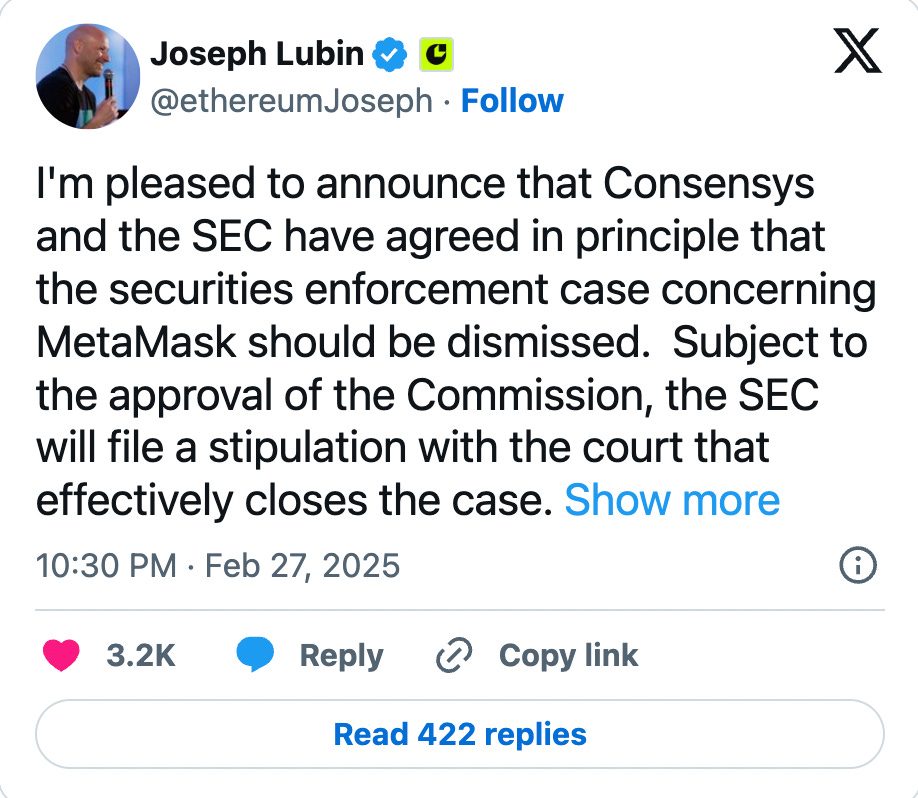Hello!
Nations including Pakistan and El Salvador are betting their treasuries on magic internet money and the IMF is having a meltdown.
Check out our Thursday edition to know more.
Bitcoin has Saylor. Ethereum has Joe Lubin.
Ethereum's co-founder who just convinced a casino marketing company to bet $425 million on programmable money.
His latest moves include becoming chairman of SharpLink Gaming and negotiating with sovereign wealth funds about building financial infrastructure on Ethereum. The SEC just dropped its lawsuit against his company ConsenSys, clearing the regulatory deck for bigger plays.
Lubin's path to crypto ran through Princeton robotics labs, Goldman Sachs trading floors, and Jamaican music studios. His approach has been methodical: build the infrastructure first, let adoption follow.
Sign up to get Token Dispatch in your inbox 👇🏻
The Goldman Sachs Exit
Joe Lubin's crypto story starts with proximity to financial disasters and not ideological conviction.
September 11, 2001: Lubin, a VP of Technology in Goldman Sachs' Private Wealth Management division, witnesses the World Trade Center attacks. Seven years later, he observes the global financial crisis from inside Wall Street.
His response was atypical. Instead of doubling down on traditional finance, Lubin decamped to Jamaica to produce music.
This wasn't a midlife crisis. Financial systems had demonstrated their vulnerabilities twice in a decade, and Lubin had front-row seats both times.
His route to Goldman Sachs followed a predictable pattern. Princeton University for Electrical Engineering and Computer Science. Three years managing the Robotics and Expert Systems Laboratory, working on machine vision and autonomous vehicles. A stint at Vision Applications building autonomous mobile robots. Then finance through software consulting.
By the late 1990s, Lubin occupied the sweet spot where ambitious technologists aimed to land – technology meets serious money. His Princeton roommate Michael Novogratz was making similar moves in traditional finance.
Then the towers fell, the markets crashed, and Lubin decided predictable wasn't worthwhile.
Following his disillusionment with traditional finance, Lubin moved to Jamaica with his girlfriend and became a music producer.
Except that what followed reads less like retreat and more like field research.
The Bitcoin Discovery
In 2009, while engineering music software in Jamaica's dancehall scene, Lubin encountered the Bitcoin whitepaper.
"When I encountered this technology, I had that 'Bitcoin moment' that so many of us have experienced: this has the potential to change everything," he later recalled.
Lubin's Bitcoin moment differed from typical crypto conversion stories. His excitement centred on engineering solutions to systemic problems rather than libertarian ideals or financial speculation.
The 2008 financial crisis had demonstrated how centralised financial institutions could amplify risk across entire economies. Bitcoin offered an alternative: a monetary system that could operate without intermediaries who'd just proven themselves unreliable.
For four years, Lubin accumulated Bitcoin while most of the financial world dismissed it. He wasn't building communities or evangelising. He was studying.
In January 2014, everything shifted.
The Ethereum Encounter
"In November 2013, Vitalik Buterin wrote the first version of the Ethereum white paper. On January 1, 2014, I spoke with Vitalik about it and received a copy. That was my Ethereal moment. I checked back in — all in," he said.
Buterin had imagined a programmable blockchain capable of more than value transfer. Lubin, with his background in robotics and autonomous systems, grasped the implications.
Within months, Lubin had positioned himself as Ethereum's business architect. While Buterin handled technical vision, Lubin managed the practical realities of transforming a whitepaper into a functioning system.
The process included drama. The Ethereum founding team gathered in Zug, Switzerland, on June 7, 2014, planning to structure Ethereum as a for-profit company. Internal politics intervened. After private deliberation, Buterin announced that Charles Hoskinson and Steven Chetrit were out, and Ethereum would become a nonprofit foundation.
Lubin and others called this the "Red Wedding," referencing the Game of Thrones betrayal scene. For Lubin, it created an opportunity rather than a setback.
The Ethereum Foundation would focus on protocol development. Someone else would need to build the commercial infrastructure that would make Ethereum useful for enterprises and institutions.
Building the Infrastructure Stack
ConsenSys launched in October 2014, concurrent with Ethereum's mainnet launch. Lubin's approach was systematic: build every piece of infrastructure Ethereum would need to function as a financial system foundation.
Rather than betting on a single application, ConsenSys incubated projects across the entire Ethereum stack:
Infrastructure: Infura provides API access to Ethereum nodes. Most DeFi applications depend on it to function.
User Interface: MetaMask became the primary gateway for millions to access Ethereum applications.
Developer Tools: Truffle Suite became standard for Ethereum development.
Enterprise Solutions: Kaleido offered blockchain-as-a-service for corporations building in-house.
Lubin described the early phase as a "chaotic incubator" that spawned more than 50 businesses. Critics called it unfocused. Lubin called it ecosystem building.
The approach reflected his engineering background. In robotics, you build sensing systems, processing systems, actuation systems, and coordination protocols. Lubin applied similar systematic thinking to Ethereum.
The Progressive Decentralisation Theory
Lubin's philosophical framework for building decentralised systems using centralised entities became known as "progressive decentralisation."
The concept addresses a practical problem: How do you bootstrap decentralised networks when decentralised coordination is inherently difficult?
Lubin's approach: Start centralised, build infrastructure, then gradually transfer control to the community as the technology matures.
The strategy has played out across ConsenSys projects with mixed results. Truffle Suite became open-source with community-driven development. ConsenSys has spun out dozens of projects as independent entities, including Gnosis, reducing its direct control over the ecosystem.
But the transition remains incomplete. MetaMask still operates largely under ConsenSys control, while Infura has discussed plans for decentralised node distribution without specific timelines.
"There's nothing wrong with having an entity that is organised in one way that is trying to build something that is organised in a different way," he argues.
This philosophy allowed ConsenSys to build Ethereum infrastructure without getting bogged down in governance debates or community politics. It also positioned Lubin as the coordinator of Ethereum's commercial ecosystem while maintaining distance from protocol governance.
The Regulatory Victory
In February 2025, the SEC agreed to drop its lawsuit against ConsenSys. The case alleged that ConsenSys made over $250 million in fees through MetaMask's staking and swap services, violating securities laws.
ConsenSys had counter-sued in April 2024, arguing that treating ETH as a security would criminalise basic network usage.
The SEC dropped the case with no fines or conditions, citing "a new direction" under Trump administration leadership. "Now we can get 100% back to building. 2025 is going to be the best year yet for Ethereum and Consensys," Lubin stated.
The SharpLink Deal
In May 2025, SharpLink Gaming, an affiliate marketing firm for online casinos, announced a $425 million private placement to build an Ethereum treasury. Joe Lubin became chairman of the board.
The Michael Saylor comparisons were immediate.
Like Saylor's MicroStrategy, SharpLink is using corporate treasury strategy to make a large bet on a cryptocurrency. Like Saylor, Lubin is positioning himself as the public face of institutional adoption.
SharpLink's stock jumped over 400% following the announcement, gaining more than 900% over the past month. The participation list included established crypto venture capital firms: ParaFi Capital, Electric Capital, Pantera Capital, Arrington Capital, Galaxy Digital, Republic Digital.
Lubin has filed for SharpLink to raise an additional $1 billion, with "substantially all" designated for ETH purchases. If successful, it would create one of the largest corporate cryptocurrency treasuries.
The model represents active utility rather than passive speculation.
SharpLink's stock jumped over 400% following the announcement, gaining more than 900% over the past month. The participation list included established crypto venture capital firms: ParaFi Capital, Electric Capital, Pantera Capital, Arrington Capital, Galaxy Digital, Republic Digital.
Lubin has filed for SharpLink to raise an additional $1 billion, with "substantially all" designated for ETH purchases. If successful, it would create one of the largest corporate cryptocurrency treasuries.
The model represents active utility rather than passive speculation.
The Sovereign Fund Claims
The SharpLink deal may be preliminary to larger moves.
In a recent podcast appearance, Lubin stated that ConsenSys is "in talks with sovereign wealth funds and major banks in a 'very big' country to build infrastructure across the Ethereum ecosystem."
He declined to name the country. The discussions reportedly centre on building institutional infrastructure within the Ethereum ecosystem, including both layer-1 and customised layer-2 solutions.
If accurate, this would represent validation of Lubin's decade-long bet on Ethereum infrastructure. It would also position Ethereum differently from other cryptocurrencies: as foundation layer for national financial systems.
The timing aligns with Central Bank Digital Currency (CBDC) development moving from experimental to implementation phases. Governments need programmable money infrastructure, and Ethereum offers the most established developer ecosystem and institutional tooling.
Lubin frames this as logical progression: "Ethereum is uniquely positioned to anchor the next phase of the global financial system."
Token Dispatch View 🔍
At 61, Lubin oversees a crypto empire built around the tools that actually make Ethereum usable. ConsenSys's most significant creation is MetaMask – the browser wallet that became the gateway for millions to access DeFi.
Without MetaMask, the Ethereum ecosystem would likely still be trapped in developer-only territory. The company has incubated dozens of other projects, from Infura's critical node infrastructure to Truffle's development tools.
Rather than hiring traditional tech workers, ConsenSys assembled an unusual mix: entrepreneurs who think like engineers, protocol architects who understand business, and enterprise specialists who can translate blockchain concepts for Fortune 500 boardrooms.
The SEC victory clears regulatory uncertainty around ConsenSys's core products. The SharpLink treasury deal provides a public market vehicle for Ethereum institutional adoption. The sovereign fund discussions, if they materialise, could position Ethereum as infrastructure for national financial systems.
Lubin's vision extends beyond financial applications to a complete transformation of internet architecture – a decentralised World Wide Web (Web 3.0) where users own their data, applications resist censorship, and economic value flows directly between creators and consumers.
"Entrepreneurs and technologists are pouring into the ecosystem to build out the decentralised world wide web, Web 3.0. Once you've seen the profound implications of blockchain, you can't unsee it. Each new wave of the hype cycle will bring larger and larger cohorts of builders and users. For these people, there is no turning back," he explained.
His recent moves suggest this vision is transitioning from theory to practice.
That's it for this week's HashedIn.
See ya, next Friday.
Until then … stay curious,
Thejaswini
Don't forget to whitelist thetokendispatch+hashedin@substack.com to ensure you’ve got me each week in your primary inbox.
Token Dispatch is a daily crypto newsletter handpicked and crafted with love by human bots. You can find all about us here 🙌
If you want to reach out to 200,000+ subscriber community of the Token Dispatch, you can explore the partnership opportunities with us.
Fill out this form to submit your details and book a meeting with us directly.
Disclaimer: This newsletter contains analysis and opinions, not financial advice. Trading crypto involves substantial risk - your capital is at risk. Do your own research.









